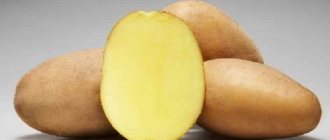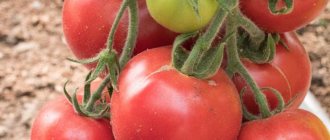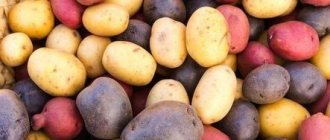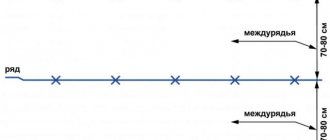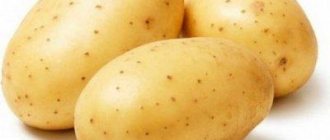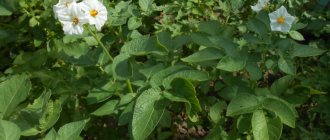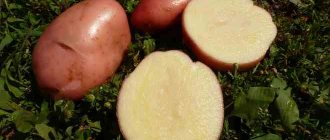Saxon
Saxon potatoes are an early ripening variety for table use. Included in the State Register for the Central (3) region. The plant is low to medium height, semi-erect to spreading. Medium sized leaf, green. The leaf is medium sized, narrow. The edge waviness is average.
Russian Potatoes. Mid-early, suitable for the production of crispy potatoes and mashed potatoes. Included in the State Register for the Central (3) region. Plant of medium height, intermediate type, spreading. The leaves are small, green to dark green.
Description and characteristics of the variety
Carlena potatoes are included in the category of mid-early varieties. The vegetative stage lasts 65-80 days. The vegetable has a culinary table purpose - type AB. The bushes are strong, the height is average - within 50-60 cm. The buds are red-violet.
The variety was bred by German scientists and has been registered in Russia since 1997.
Signs of tubers:
- average weight 59-111 g;
- starchiness 11.6-13.2%;
- the skin is yellowish, there is a light mesh;
- the flesh is yellow;
- round-oval shape;
- texture is dense;
- eyes few, small (1-2 mm).
Potatoes are used for boiling in their jackets (for side dishes and salads), for frying and baking. The tubers are used to make chips, and you can use them to make French fries. The harvest is well preserved, keeping quality is 95%.
The variety has strong immunity (results after testing by the All-Russian Research Institute of Phytopathology):
| Resistance | Name |
| Strong | Potato virus Nematode Blackleg Leaf roll virus Scab Glandular spot Rhizoctoniosis |
| Moderate | Phytophthora tops |
Rikea
Rikey potatoes are an early ripening variety for table use. Included in the State Register for the North-Western (2) and Central (3) regions. Plant of medium height to tall, intermediate type, semi-erect. The leaf is medium sized, light green to green.
Nakra potato is a mid-season variety suitable for making crispy potatoes. Included in the State Register for the West Siberian (10) region. The plant is tall, intermediate type, erect. Medium sized leaf, green. Medium sized leaf.
Article on the topic: Potato variety “Corona” - description and photo
Don't forget to update your potato varieties
Every day, potatoes take pride of place on our table. No wonder people call it the second bread. What needs to be done to ensure that this crop consistently produces a good harvest and how to store it. We asked Z.F. to answer these and other questions from our readers. Sergeev, director of the selection station, head. potato laboratory.
– Zoya Fedorovna, first of all, this is a question. In private gardens, the potatoes produced quite well, but most of the tubers were cracked and ugly in shape. What is the reason?
– In adverse weather conditions. The shape of tubers is affected by both excess moisture in the soil and its lack. Heavy soil also contributes to cracking of tubers. Ideally it should be loose.
- The potatoes have been harvested. How to preserve it, because the tubers can rot?
– After harvesting, the grown crop of second bread should not be immediately stored for storage, but should be kept for two weeks. It is advisable to turn the tubers selected for planting green and keep them in the light. During this period, all diseases will manifest themselves. From the total mass, it is imperative to remove tubers affected by scab, mechanically damaged and eaten by wireworms. Such tubers are outwardly healthy, but they are the first to be affected by rot.
The level of the potato mound should be no more than a meter. The optimal temperature for its storage is from 2 to 4 degrees. It’s a good idea to cover the mound with rowan leaves and spruce branches – they emit phytancides. And, of course, constantly monitor the storage of tubers.
– What varieties would you recommend growing in private gardens?
– Those that are adapted for our zone. From the early varieties: Ognivo, Bagach, Golubka, Albatross; from the middle-early: Visa, Gloria, Lada, Uslada; from mid-ripe: Chaika, Lukoshko, Derevenka, Vulcan. But of all the varieties listed, Gloria, Uslada, Lukoshko, and Derevenka have very good taste. At the same time, I note that those varieties that have a longer growing season accumulate more nutrients.
And in order for the second grain to always produce good yields, it is necessary to update the planting material at least every five years. Seed tubers must be purchased by at least the elite, and from scientific institutions, and not from private individuals.
– Recently, private owners have been using mustard as a green fertilizer (green manure) on their potato plots. What would you recommend?
– This is a business matter, but I am inclined to sow winter rye. This crop disinfects and clears the soil of weeds very well and serves as a good fertilizer.
– And if it is possible to alternate planting potatoes with sowing herbs, what is better to sow?
– Legumes and even beans are used as a precursor, which even cleanse the soil of potato nematodes.
– Is it possible to use potato tops in the garden after they rot?
“It’s better to destroy it—burn it.” Many diseases remain on the tops, which do not die in winter; they can be transferred back to the soil.
– Nowadays there is a lot of talk about different methods of planting potatoes, for example, planting according to Fokin, that is, cultivating the soil with a flat cutter to a depth of 8-12 cm. Or not plowing at all, but spreading out the potatoes and covering the top with straw, hay or other vegetation. Are such methods acceptable in our conditions?
– For those who are interested in these methods of planting potatoes, please experiment. In general, for potatoes you need to plow the soil in the fall to a depth of 30 centimeters and in the spring to a depth of 22-25 cm. Potatoes have a fibrous root system and are located at this depth. It is better to plant tubers in ridges, because the soil in them warms up faster and it is easier to hill up the plantings later.
– Is it possible to pick off sprouts from potatoes in the spring if they are large?
– Yes, it’s better to pick and warm the seed tubers at a temperature of 18-20 degrees so that new shoots appear from the eyes.
– What is the best time to plant potatoes?
– The second ten days of May, according to popular belief: when the bird cherry blossoms.
- Thank you for the interview.
Diseases and pests
In general, the variety is resistant to diseases, but preventive plant treatments should not be abandoned. You should start by processing the planting material before sowing.
- To protect against late blight, they resort to spraying with garlic infusion or Metaxil with breaks of 2 weeks between treatments.
- To combat the Colorado potato beetle, potato bushes are sprinkled with ash or specialized preparations are used.
Late blight on potatoes
The Antonina potato variety is still perceived by vegetable growers as a novelty in the field of breeding. Those who have managed to get acquainted with it in practice note its resistance to the whims of the weather and the ability to collect early harvests. With proper care, the plants do not get sick and produce a good harvest of tasty tubers.
Growing and care
Cultivation of the variety is not difficult, but regular care is required.
Features of watering
Potatoes require less watering than other nightshades. It is watered during the period of budding and subsequent flowering, abundantly, moistening the soil 50 cm deep. Watering is also required during dry periods when there is no rainfall for a long time.
It is recommended to use lukewarm water.
Feeding and fertilizing
The variety is fed three times:
- When planting, add 1 tsp. nitrophoska into each hole, but at the same time place the tubers so that they do not come into direct contact with the fertilizer.
- 2-3 weeks after germination, water with a solution of 1 tsp. urea per bucket of water.
- During the budding period, prepare a decoction or solution of wood ash (3 tablespoons per bucket of water, more is possible).
Special complexes for potatoes are also useful.
Hilling and weeding
Hilling must be carried out several times per season. The first time is spud the recently hatched seedlings above the ground, then repeat after 2 weeks.
Regular, timely hilling helps protect plantings from the Colorado potato beetle.
Weed weeds every 7-10 days or as they appear. At the same time, carefully loosen the soil.
Features of fruiting
The trees are medium-sized, with a fairly compact, rounded crown. As it grows, it becomes broadly oval, prone to thickening. Such trees require timely pruning. Fruiting, as a rule, is regular, of a mixed type: the crop is formed on the ringlets, and on the spears, and at the ends of the branches of the vegetative type. Bud awakening and shoot formation can be either moderate or very high. The color of the bark on the trunk is dark gray, on the skeletal (oblique-vertical) branches - gray. The shoots are thin, of medium length, round in cross-section, dark brown, slightly pubescent, with short internodes.
During the flowering period (early June), the trees are covered with snow-white flowers
The leaves, directed upward, are large, ovate, with a short pointed tip. The lower surface of the leaf is heavily pubescent. The color is bright green, with a shine. The petiole is of medium length and thickness, colored along its entire length.
Productivity and specificity of pollination
Like the vast majority of crop varieties, “Uslada” is self-sterile and needs pollinating partners - apple trees, for example “Bogatyr”, “Orlik” or “Welsie”.
The variety is early-bearing, propagated seedlings bear their first fruits in the 4-5th year of growth in the garden. The average productivity of one tree is 60-80 kg. Reviews of the Uslada apple tree often mention that in order to obtain high yields, annual crown formation is necessary, since its thickening leads to unevenness of the fruit.
During the period of ovary formation, the growth of the branches weakens, and they begin to be overloaded under the weight of the filling apples. Experts recommend trimming the growth further so that the apple tree remains strong longer and the fruits do not decrease in size. All the details of pruning are explained in detail and clearly by an experienced gardener in the following video:
Landing
The variety is grown from tubers, less often - from seeds through seedlings (every few years, when it is necessary to renew the crop). Prepare the soil for planting:
- It is preferable to choose neutral or slightly alkaline soil;
- acidity is reduced using ash or dolomite flour;
- select beds after legumes, cucumber, zucchini, cabbage, radishes, radishes, carrots, onions. Areas after tomatoes, eggplants and peppers are contraindicated;
- the bed is dug to a depth of at least 30 cm, first in autumn, then in spring;
- When digging, compost is added in the fall, and mineral fertilizers are added in the spring.
Pre-sprouted tubers are planted according to a 30 by 70 cm pattern. Planting depth is from 10 cm to 15-20 on loose, light soils.
Sprout potatoes in a bright place.
Line of varieties from NORIKA - high and high-quality potato yield
On this foundation, NORIKA developed as a breeder and seed producer of highly productive potato varieties, and today the company is a reliable partner for entrepreneurs in agriculture, trade and processing industry.
Quality control at every stage
NORIKA-SLAVIA LLC is the exclusive representative of NORIKA in the Russian Federation, supplying elite seed material to Russia from Germany, supervising the production and sale of seed potatoes produced in Russia, as well as consulting and providing technological support.
The company pays special attention to the health of the source seed material. Since 2013, all NORIKA original seeds have been produced in the northern part of the island of Rügen, located in the Baltic Sea - in Germany, and on an island in the delta of the Northern Dvina River in the Arkhangelsk region in Russia. These territories have: excellent spatial isolation; absence of virus carriers and sources of bacterial diseases; soils ideal for seed potato production.
Varieties from NORIKA were created and selected by breeders for different areas of use, so potato growers can choose specific varieties to suit their requirements. But in addition to the choice of variety, the quality of the initial planting material plays a decisive role, and the company assigns a primary role to the quality of planting material for its varieties. Thus, the NORIKA company has a program for quality control of seed potatoes, aimed at tracking the quality of batches, from their formation in Germany to acceptance at the buyer’s warehouse, which allows us to have objective information about the condition of the seeds at each stage.
Line of Norika varieties
Seed production in Germany and Russia
The seed material offered by the company is produced by farmers in Germany under licenses, with constant consultation and control by NORIKA specialists and seed inspection.
Delivery of seed material is a difficult path from producer to buyer, and NORIKA-SLAVIA LLC has many years of experience in completing it correctly. Briefly, the scheme looks like this: prepared batches of seed potatoes are stored in Germany, then transported by road in big bags of 1000 kg using refrigerators. The company ensures delivery to farm warehouses in compliance with temperature conditions, mandatory cargo insurance and compliance with all phytosanitary and customs procedures.
By the way, the history of localizing the production of seed potatoes of NORIKA breeding varieties began in 2004, when NORIKA-SLAVIA LLC began an import substitution program together with Agro LLC. The source material of the NORIKA varieties was transferred, which served as the beginning of the production of minitubers and subsequent categories of original and elite seed potatoes in the Russian Federation. From 2005 to 2013, NORIKA-SLAVIA LLC worked with Kostroma Potato LLC, whose task was to multiply super-elite seeds from Germany to elite classes and 1-2 reproductions.
Since 2013, NORIKA-SLAVIA LLC has expanded its seed program in the Russian Federation, starting the production of original and elite seeds in the Arkhangelsk and Moscow regions. VALMIX LLC is a reliable partner and manufacturer of high-quality elite class seed material and reproductive seeds. In the Arkhangelsk region, the company is engaged in seed production of the original category of seeds from minitubers, and Doka - Gene Technologies LLC produces minitubers of NORIKA varieties on a contract basis, thereby completing the NORIKA program for import substitution and production of seed material in the Russian Federation.
Varieties from NORIKA are distinguished by: high yield potential, good presentation, excellent taste, resistance to viral and bacterial diseases, mechanical damage, excellent shelf life, stable commercial quality, etc.
To date, the register of breeding achievements approved for use in the Russian Federation includes 22 varieties of Norika selection: Adretta, Albatross, Bonus, Valiza, Vega, Wendy, Vilow, Gala, Delikat, Inara, Karatop, Karlena, Keya, Kibits, Liu, Merlot, Molly, Pirol, Romanze, Toucan, Pheasant, Fidelia.
GALA - the “locomotive” in the NORIKA line
This is a truly unique plastic variety that never ceases to amaze. In the 2015 season, a yield of 105 t/ha was obtained on an irrigated plot in the Moscow region. GALA is a highly commercial mid-early table variety with a beautiful round-oval tuber shape, yellow skin and yellow pulp.
Tubers with very small eyes are resistant to mechanical stress, not prone to black spotting and darkening when raw, which makes the variety attractive for washing, cleaning and packaging.
The yield of the variety is high, the number of tubers per bush is 20–30. Responsive to watering. The variety has excellent taste properties, a slightly boiled type of cooking, which makes it universal in the kitchen. The variety is highly resistant to: virus Y, tuber blight, rhizoctonia, black leg and glandular spot, as well as scab. In practice, the GALA variety is grown in Russia from Kaliningrad to Novosibirsk, and from Arkhangelsk to the southern borders, which confirms its flexibility in production and popularity among consumers.
VEGA - growing popularity
Indicators of high and high-quality yield, even in conditions of lack of moisture, are distinguished by the VEGA variety, which is gaining popularity in Russia and Europe - a mid-season table variety of a new generation with a beautiful oval tuber shape, yellow skin and dark yellow pulp. The pulp is distinguished not only by its rich color, but also by its resistance to darkening in raw and boiled form.
This is a larger tuber variety than GALA, also high-yielding, so the average number of tubers in a nest is less - 12–15, drought-resistant. The taste is excellent, slightly boiled, universal type of cooking. It is highly resistant to: virus Y, late blight of tubers and tops, rhizoctonia, black leg and scab. This variety has all the prerequisites to be in the top set of varieties of Russian potato producers. Firstly, the VEGA variety is a “daughter” of the GALA variety, which means that the genetic potential of the variety is very high; secondly, VEGA is more flexible in terms of moisture than GALA, it is not so demanding on watering, it consistently lays 12–15 tubers and stretches them to the desired size.
PIROLE AND KIBITZ - for processing into chips
PYROLE is a variety with a consistently low content of reducing sugars during storage, the tubers of which can be used for processing even after long-term storage.
KIBITZ is the only potato chip variety of its kind that does not change the structure of sugars and maintains the product quality necessary for the production of chips under storage conditions of +4 °C.
KIBITZ, thanks to its beautiful shape and the possibility of low-temperature storage, can also be used on the table potato market with a starch content of 17–18%.
Starting this season, potato producers for Frito Lay began growing these two varieties for further use for processing. Also, these varieties, especially the KIBITS variety, show excellent results in Siberia, where they are produced and processed into chips.
INARA - fast and friendly germination of tubers
INARA is a mid-season variety of a new generation with excellent taste, a beautiful oval tuber shape and suitability for washing and packaging due to the tubers’ resistance to mechanical harvesting.
The INARA variety is also characterized by good shelf life with a stable storage period, during which germination is observed up to three times. Breaking off the sprouts does not affect germination, which is important when planting and has a positive effect on the rapid and friendly germination of tubers.
FIDELIA - “salad variety”
FIDELIA is a new, early table variety that can be classified as a “salad variety”. Thanks to the non-soggy type of cooking A and the stability of the product, boiled and sliced potatoes are not destroyed in mayonnaise and other dressings, which is an important characteristic for their use in the production of salads.
WENDY - both dining and industrial
The WENDY variety is another variety whose “parent” is the GALA variety. WENDY is a round-oval variety with excellent taste and a very long shelf life without a tendency to premature germination.
The variety is interesting both in the sector of production of fresh table potatoes and in the sector of industrial production of semi-finished products due to its beautiful round-oval shape, smooth mesh skin, shallow eyes, excellent taste, and the possibility of mechanical cleaning.
